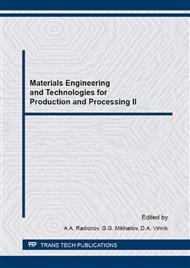[1]
N.P. Lyakishev, M.I. Alymov, Nanoscale structural materials, Nanotechnologies in Russia. 1-2 (2006).
Google Scholar
[2]
R.Z. Valiev, J.M. Alexandrov, Y.T. Zhu, T.C. Lowe, Paradox of strength and ductility in metals processed by severe plastic deformation, J. Mater. Res. 17 (2002).
DOI: 10.1557/jmr.2002.0002
Google Scholar
[3]
R.Z. Valiev, Nanomaterial advantage, Nature. 419 (2002) 887-889.
Google Scholar
[4]
Y. Wang, M. Chen, F. Zhou, E. Ma, High tensile ductility in a nanostructured metal, Nature. 419 (2002).
Google Scholar
[5]
M.L. Bernshtein, Strain structure of metals, Metallurgiya, Moscow, (1977).
Google Scholar
[6]
M.L. Bernshtein, L.M. Kaputkina, S.D. Prokoshkin, S.V. Dobatkin, Metals, Izvestiya AN USSR. 2 (1982) 94-103.
Google Scholar
[7]
M.L. Bernshtein, V.A. Zaymovsky, L.M. Kaputkina, Thermomechanical treatment of steel, Metallurgiya, Moscow, (1983).
Google Scholar
[8]
A.G. Rahshtadt, Spring steels and alloys, Metallurgiya, Moscow, (1982).
Google Scholar
[9]
V.S. Ivanova, The role of dislocations in strengthening and rupture of metals, Nauka, Moscow, (1965).
Google Scholar
[10]
A.T. Inglish, U.A. Bakofen, Influence of metal processing on rupture, Metallurgiya, Мoscow, (1983).
Google Scholar
[11]
O.I. Shavrin, Nanosized Structure Formation in Machine Part Material, Vestnik ISTU. 1 (2011) 4-6.
Google Scholar
[12]
V.B. Kosterev, Yu.F. Ivanov, V.E. Gromov, G.V. Stepanov, S.V. Konovalov, Mechanisms of nanoscale phases formation at thermal mechanical strengthening of low alloyed steel, Izvestiya vysshikh uchebnykh zavedenii, Chernaya metallurgiya. 8 (2011).
Google Scholar
[13]
R.Z. Valiev, G.V. Klevtsov, N.A. Klevtsova, V.M. Kusnarenko, A.V. Ganeev, Sturctural strength and corrosion resistance of nanostructured steel, Izvestiya vysshikh uchebnykh zavedenii, Chernaya metallurgiya. 6 (2014) 66-69.
DOI: 10.17073/0368-0797-2014-6-66-70
Google Scholar
[14]
O.I. Shavrin, Influence of Nanotechnology on Coiled Springs Operational Characteristics, Nanostructures, nanomaterials and nanotechnologies to nanoindustry. (2014) 260-272.
DOI: 10.1201/b16956-31
Google Scholar
[15]
V.F. Terentiev, Fatigue strength of metals and alloys, Intermet Engineering, Moscow, (2002).
Google Scholar
[16]
O.I. Shavrin, Experience of induction heating application for high temperature thermomechanical treatment, Induction heating. 14 (2010) 31-35.
Google Scholar
[17]
O.I. Shavrin, A.N. Scvortsov, L.M. Maslov, Manufacturing schemes of nanoscalestructure formation in machine parts, Machines, Technologies, Materials. 6 (2015) 34-37.
Google Scholar
[18]
A.S. Tetelman, A.G. Avily, Rupture of high-strength materials, Metal rupture, volume 6, Metallurgiya, Moscow, (1976).
Google Scholar
[19]
O.I. Shavrin, High-strength springs for rolling stock railways, Bulletin of the Institute of Natural Monopolies Research: Railway equipment. 3 (2012) 71-80.
Google Scholar


